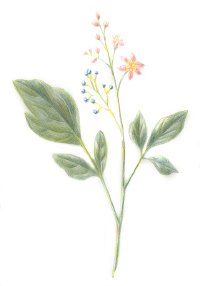Early Americans learned from the Native Americans to use blue cohosh, also called blue ginseng, squaw root, or papoose root, as a women's herb. Pioneer physicians were so impressed by this Native American medicine that they listed blue cohosh as an official medicine in the U.S. Pharmacopeia. Today the blue cohosh is used, primarily, in herbal remedies for gynecologic conditions.
Uses of Blue Cohosh
Blue cohosh is used primarily for uterine weakness and as a childbirth aid. It is considered a uterine stimulant in most circumstances because it improves uterine muscle tone. But blue cohosh also has an antispasmodic effect on cramps. Because of its dual actions, herbalists describe blue cohosh as a uterine tonic. Methyl cytosine, an alkaloid found in blue cohosh, is thought to be antispasmodic, while the triterpenoid saponin hederagenin is thought to provide the increased uterine tone.
Advertisement
Blue cohosh is classified as an emmenagogue, meaning it stimulates menstrual flow. It dilates blood vessels in the uterus and promotes circulation in the pelvis, making it helpful for women who experience scanty, spotty menstrual flow; irregular periods; and difficult, painful periods.
Blue cohosh seems to work best for women whose menstrual cramps are most painful on the first day of their periods. You may use blue cohosh to relieve menstrual cramps and to treat a weak, worn-out, or sluggish-acting uterine muscle -- indicated by no cramps or weak cramps, but prolonged bleeding; weak pelvic, abdominal, and thigh muscles; and an aching, dragging sensation during the menstrual period. Blue cohosh also may be useful in cases of breast tenderness and abdominal pain caused by fluid retention.
Blue cohosh helps correct uterine prolapse (sagging of the uterus in the pelvic cavity). This condition may stem from multiple childbirths or tissue laxity due to overweight or obesity. Blue cohosh also may help the uterus shrink back to its appropriate size after childbirth, although women who are breastfeeding their infants should avoid taking it. Up until the 1970s, herbalists also used blue cohosh to improve the muscle tone of the uterus during childbirth. During pregnancy, however, women should avoid all products that contain blue cohosh, as there have been several cases of problems reported. In one case, a newborn infant suffered stroke, and in another, the infant was born with congestive heart failure.
Many Native American tribes used large doses of strong root decoctions of blue cohosh for preventing conception; herbalists no longer recommend this practice because the herb is unreliable for this purpose.
Blue cohosh is a diuretic -- an agent that promotes urination -- and a weak diaphoretic -- an agent that raises body temperature and promotes sweating -- which may help break a fever.
In the next section, you will learn how to prepare blue cohosh for herbal remedies and some of the potentially dangerous side effects.
To learn more about treating common medical conditions at home, try the following links:
- For an overview of all of our herbal remedies, go to the main Herbal Remedies page.
- To learn more about treating medical conditions at home, visit our main Home Remedies page.
- One of the best things you can do for your health and well being is to make sure you are getting enough of the vital nutrients your body needs. Visit our Vitamins page to learn more.
This information is solely for informational purposes. IT IS NOT INTENDED TO PROVIDE MEDICAL ADVICE. Neither the Editors of Consumer Guide (R), Publications International, Ltd., the author nor publisher take responsibility for any possible consequences from any treatment, procedure, exercise, dietary modification, action or application of medication which results from reading or following the information contained in this information. The publication of this information does not constitute the practice of medicine, and this information does not replace the advice of your physician or other health care provider. Before undertaking any course of treatment, the reader must seek the advice of their physician or other health care provider.Before engaging in any complementary medical technique, including the use of natural or herbal remedies, you should be aware that many of these techniques have not been evaluated in scientific studies. Use of these remedies in connection with over the counter or prescription medications can cause severe adverse reactions. Often, only limited information is available about their safety and effectiveness. Each state and each discipline has its own rules about whether practitioners are required to be professionally licensed. If you plan to visit a practitioner, it is recommended that you choose one who is licensed by a recognized national organization and who abides by the organization's standards. It is always best to speak with your primary health care provider before starting any new therapeutic technique.
Advertisement
